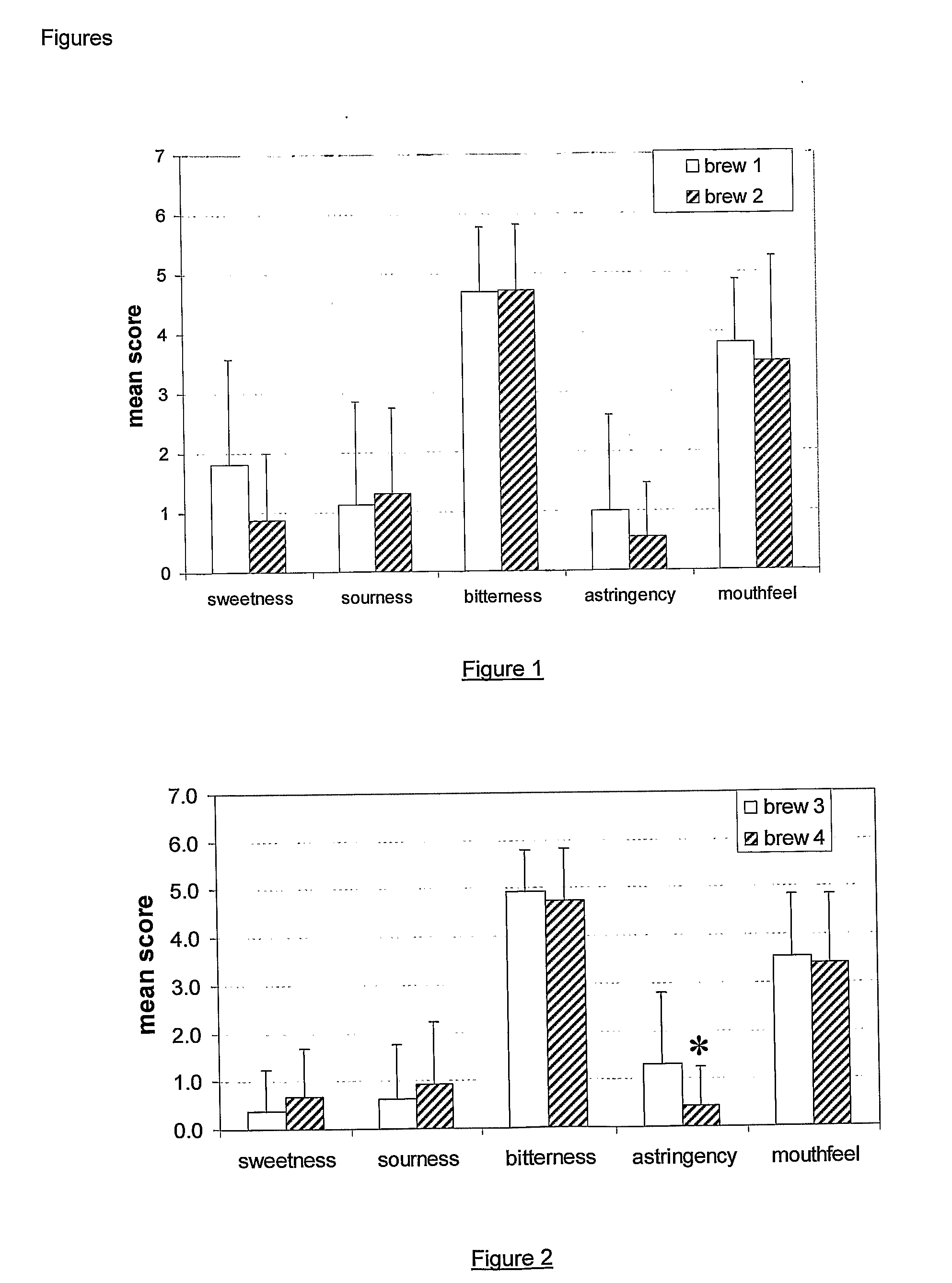Method for brewing beer
a bottom fermented beer and beer technology, applied in the field of bottom fermented beer brewing, can solve the problems of affecting the taste of beer, so as to improve the quality of beer, improve the taste and taste stability, and improve the effect of health-related phytonutrients
- Summary
- Abstract
- Description
- Claims
- Application Information
AI Technical Summary
Benefits of technology
Problems solved by technology
Method used
Image
Examples
example 1
Clear Bottom Fermented Beer Made Using Bran as Adjunct
Materials.
[0056]Pilsner malt was purchased from Mouterij Albert (Puurs Belgium). Wheat bran and rye bran were obtained from Dossche Mills & Bakery (Deinze, Belgium) and Molens Goethals (Gent, Belgium), respectively. The carbohydrate composition of the bran fractions shown in Table 1 was determined by the method of Courtin et al. 2000, whereby the carbohydrates were first hydrolyzed to monosaccharides by acid hydrolysis, and the resulting monosaccharides detected as alditol acetates by gas chromatography. Termamyl 120 L (a thermostable alpha-amylase preparation), Attenuzyme (an amyloglucosidase preparation), and Promozyme (a pullulanase preparation) were purchased from Novozymes (Bagsvaerd, Denmark).
Analytical Techniques.
[0057]Alcohol content in beer samples was measured by near infrared spectroscopy (Alcolyzer Plus, from Anton Paar), real extract was measured by an oscillating U-tube density meter (Alcolyzer Plus, from Anton Paar...
example 2
Analysis of Bottom Fermented Beer Made Using Bran as Adjunct
Materials.
[0063]Beers 3 and 4 were made from brews 3 and 4 as described in Example 1. Commercial beers were purchased in a local store.
Analysis of Total and Free Ferulic Acid.
[0064]Beer samples (90 ml) were sonicated in a sonication bath and subsequently lyophilised. Total ferulic acid (sum of bound and free ferulic acid) content was determined on 10-50 mg samples suspended in sodium hydroxide (5 ml; 2 M, oxygen-free). The headspace over the solution was purged with nitrogen and hydrolysis of bound ferulic acid was conducted for 18 h at room temperature. o-Coumaric acid (100 μl, 50 mg / 100 ml) was added as an internal standard and the solution was acidified with hydrochloric acid (4 ml; 4 M). Then, the solution was extracted three times with ethyl acetate (3 ml, respectively), and the organic phases were combined and dried with nitrogen. The residue was dissolved in methanol (5 ml) and filtered (0.45 μm pore size filter) pri...
example 3
Effect of pH on Bottom Fermented Beers Made Using Bran as Adjunct
[0093]Two beers are prepared with addition of wheat bran to the grist as described for brew 4 in Example 1. One of the beers is made with a pH of 5.6 during the mashing step, the other one is made with a pH of 5.2, using lactic acid as the acidulating agent. Analysis shows a reduction of the presence of, amongst others, lipoxygenase related off-taste compounds in the beer made at pH 5.2 as compared to that made at pH 5.6.
TABLE 1Carbohydrate composition (expressed as % w / w monosaccharides obtainedafter acid hydrolysis on dry matter basis) of the wheat bran and rye branfactions used in the brewing experiments described in Example 1. Theglucose mainly reflects starch content and does not take into accountcellulose content, which does not hydrolyse by the acid hydrolysismethod used.Monosaccharide (as %dm after acid hydrolysis)Wheat branRye branL-arabinose8.5%8.2%D-xylose14.2%13.9%D-mannose0.4%0.7%D-galactose1.4%1.3%D-gluco...
PUM
| Property | Measurement | Unit |
|---|---|---|
| particle size | aaaaa | aaaaa |
| temperature | aaaaa | aaaaa |
| temperature | aaaaa | aaaaa |
Abstract
Description
Claims
Application Information
 Login to View More
Login to View More - R&D Engineer
- R&D Manager
- IP Professional
- Industry Leading Data Capabilities
- Powerful AI technology
- Patent DNA Extraction
Browse by: Latest US Patents, China's latest patents, Technical Efficacy Thesaurus, Application Domain, Technology Topic, Popular Technical Reports.
© 2024 PatSnap. All rights reserved.Legal|Privacy policy|Modern Slavery Act Transparency Statement|Sitemap|About US| Contact US: help@patsnap.com









